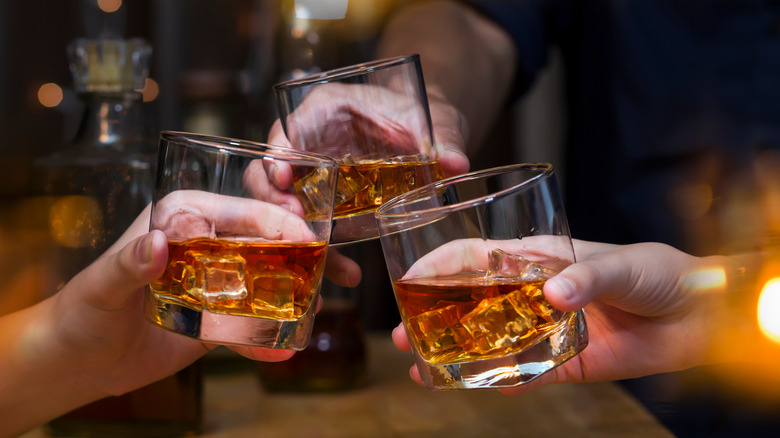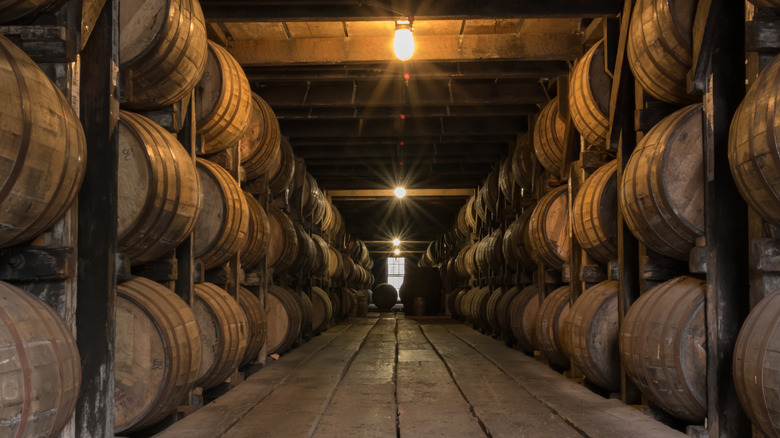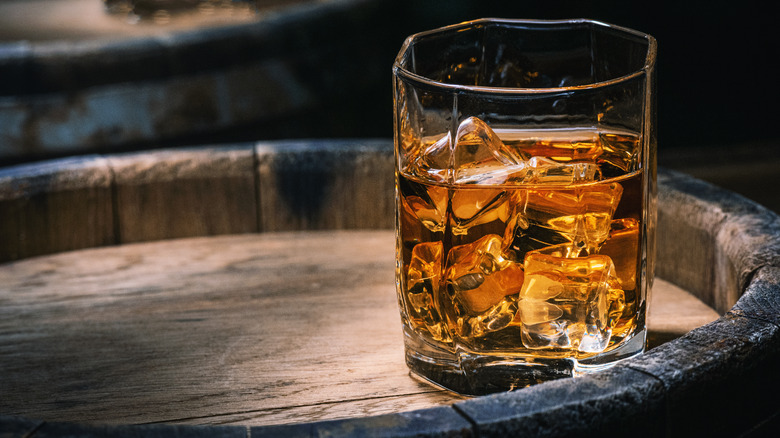The Differences Between Bourbon And Whiskey
The terms "bourbon" and "whiskey" are often used interchangeably, to the chagrin of those who are serious about their spirits. And while it's not entirely off base to think of bourbon and whiskey as one and the same, it's far from the whole truth. Bourbon is actually a type of whiskey, but with some important distinctions that make it unique. The differences in flavor between bourbon and whiskey begin with differences between how the two liquors are made.
All types of whiskey, including bourbon, rye whiskey, and Scotch, are made from some kind of fermented grain, such as barley, wheat, or corn. The grain is first ground and then cooked to turn the starches into sugar, and mixed with yeast, which in turn reacts with the sugars to form alcohol. Now that the grain mash has been fermented, it is referred to as beer, which will be further distilled in large metal vats known as stills. Stills use steam to remove water and any remaining solids from the alcohol. Once the spirit has been distilled further, it is transferred to barrels so it can age until it is ready to be bottled. While the overall process for making whiskey and bourbon is similar, there are a few key variations that lead to different final products.
The two have unique distilling processes
One of the most notable differences between bourbon and whiskey is the recipe of their initial grain mixes. As noted by the American Bourbon Association, bourbon must be made with at least 51% corn, but may also include grains like wheat or rye to create a different taste. On the other hand, whiskey in general does not have any recipe requirements other than using grains, but that's not the case for specific whiskeys. For example, a recipe of 51% rye is needed for rye whiskey. Bourbon also cannot contain any additives to change the color or flavor. Perhaps most importantly, bourbon must be made in the United States, while whiskey can be made anywhere.
Bourbon goes through the same distilling process as most other whiskeys but has a lot of peculiarities when it comes to the barreling stage. Unlike other whiskeys, which often reuse barrels, bourbon must be stored in new charred oak barrels to aid in the aging process. Additionally, rather than simply being stored upright around a warehouse, bourbon barrels are kept in ricks. Ricks, also known as racks, are able to hold barrels sideways in tall stacks. Per the American Bourbon Association, the airflow allowed by this storage solution "is a major differentiating factor in the bourbon craft." There is also a set alcohol by volume for bourbon — it must be at least 80 proof or 40% ABV.
Flavor differences between the spirits
Due to the high volume of corn used to make bourbon, the liquor is sweeter than other types of whiskey. As you take a sip, you may also notice hints of vanilla, caramel, and oak from the new charred barrels. The taste of whiskey depends on what version you choose; scotch has a smokier, woodsy flavor, while rye whiskey tastes earthier with a hint of spice. As for mixing bourbon with other ingredients, the spirit will work well in most whiskey cocktails, but there are a few recipes that let it really shine. Since bourbon originated in Kentucky, drinks like the Kentucky Mule or the classic Derby favorite, mint julep are perfect for bourbon. Like other whiskies, bourbon also pairs well with cola and is a treat when served neat.
Overall, the best rule of thumb to remember is that all bourbon is whiskey, but not all whiskey is bourbon. Bourbon is a proudly American thread in the tapestry of whiskey making. So, the next time you're out for drinks, order up a glass and truly appreciate the sweet intricacies of this delicious spirit.


